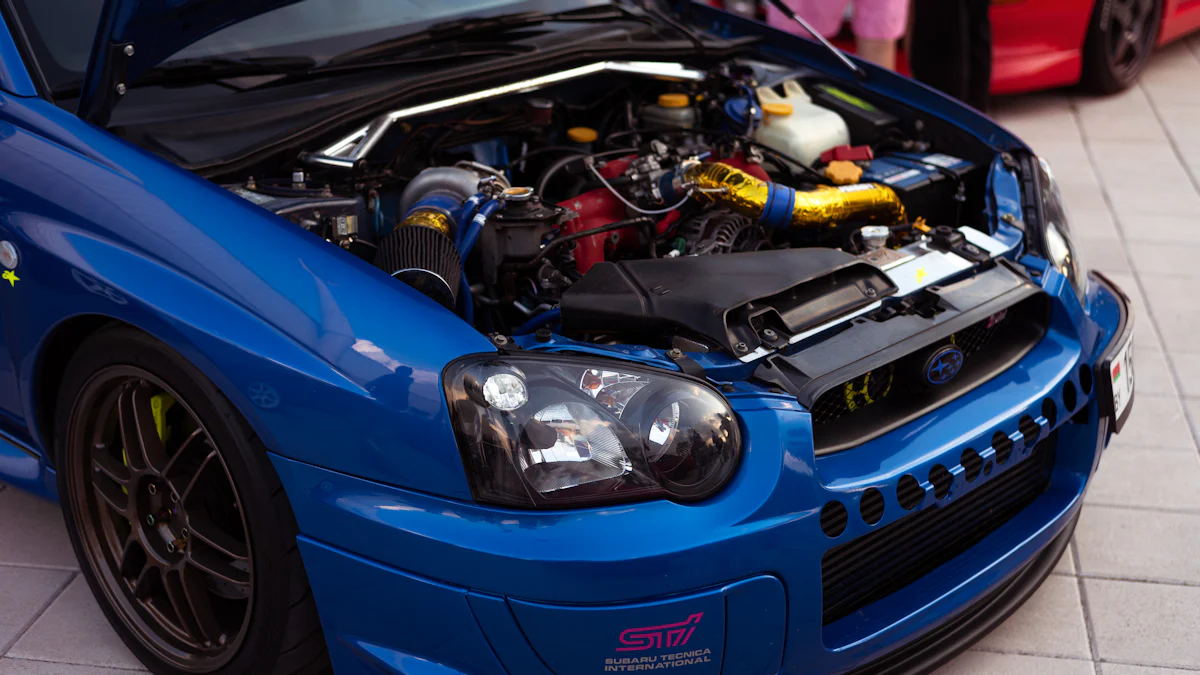
CVD TaC coating offers exceptional protection in extreme environments. Its ability to withstand high temperatures, maintain thermal stability, and resist chemical reactions makes it a preferred choice for demanding applications. Engineers and scientists rely on this advanced material to enhance performance in industries where durability and heat resistance are critical.
What is CVD TaC Coating?
Definition and Composition
CVD TaC coating, or chemical vapor deposition of tantalum carbide, is a thin protective layer applied to surfaces to enhance their performance in extreme conditions. This coating consists primarily of tantalum and carbon atoms, forming a compound with exceptional thermal and mechanical properties. Tantalum carbide exhibits one of the highest melting points among known materials, making it ideal for high-temperature applications. Its dense structure also provides excellent hardness and resistance to wear.
The unique composition of CVD TaC coating enables it to withstand harsh environments. It resists oxidation and corrosion, even when exposed to aggressive chemicals or extreme heat. These characteristics make it a preferred choice for industries requiring durable and reliable materials.
Application Process
The application of CVD TaC coating involves a chemical vapor deposition process. This method uses a high-temperature chamber where tantalum and carbon precursors react in a controlled environment. The reaction produces a thin film of tantalum carbide that adheres to the substrate surface. Engineers carefully control parameters such as temperature, pressure, and gas flow to ensure uniform coating thickness and quality.
This process creates a strong bond between the coating and the substrate, enhancing durability. The precision of CVD technology allows for the coating of complex geometries, making it suitable for a wide range of applications. Industries such as aerospace, nuclear energy, and manufacturing benefit from the superior performance of CVD TaC coatings.
Key Properties of CVD TaC Coatings

High-Temperature Resistance
CVD TaC coating demonstrates exceptional resistance to high temperatures, making it a standout material for extreme environments. Tantalum carbide, the primary component, has a melting point exceeding 3,800°C. This property allows the coating to maintain its structural integrity under intense heat. Applications in aerospace and industrial furnaces benefit significantly from this capability. The coating prevents thermal degradation, ensuring consistent performance even in prolonged high-temperature exposure.
Thermal Stability
Thermal stability is another critical property of CVD TaC coating. It resists thermal expansion and contraction, reducing the risk of cracking or deformation. This stability ensures that the coating remains effective across a wide temperature range. Engineers rely on this feature when designing components for environments with rapid temperature fluctuations. The coating’s ability to maintain its properties under thermal stress enhances the reliability of coated materials.
Hardness and Wear Resistance
CVD TaC coating offers remarkable hardness, ranking high on the Mohs scale. This hardness translates to superior wear resistance, protecting surfaces from abrasion and mechanical damage. Industries that use cutting tools, molds, and dies benefit from this durability. The coating extends the lifespan of components, reducing maintenance costs and downtime. Its dense structure ensures consistent protection against physical wear.
Oxidation and Corrosion Resistance
CVD TaC coating resists oxidation and corrosion, even in chemically aggressive environments. Its inert nature prevents reactions with oxygen and other corrosive agents. This property makes it ideal for applications in nuclear reactors and chemical processing equipment. The coating acts as a barrier, shielding the substrate from degradation. This resistance ensures long-term performance and reliability in challenging conditions.
Comparison with Other High-Temperature Coatings
TaC vs. HfC (Hafnium Carbide)
Tantalum carbide (TaC) and hafnium carbide (HfC) are both ultra-high-temperature ceramics. HfC exhibits a slightly higher melting point, reaching approximately 3,958°C compared to TaC’s 3,880°C. This makes HfC marginally more suitable for applications requiring extreme heat resistance. However, TaC offers better chemical inertness, particularly in environments with reactive gases. Its superior oxidation resistance also provides an advantage in high-temperature, oxygen-rich conditions. Additionally, the deposition process for cvd tac coating is more established and cost-effective than that of HfC coatings, making it a more practical choice for many industries.
TaC vs. SiC (Silicon Carbide)
Silicon carbide (SiC) is widely used for its excellent thermal conductivity and lightweight properties. However, SiC has a lower melting point of around 2,700°C, which limits its use in ultra-high-temperature environments. TaC outperforms SiC in terms of hardness and wear resistance, making it ideal for applications involving mechanical stress. SiC, on the other hand, is more affordable and easier to process, making it a preferred option for less demanding applications. TaC’s ability to maintain structural integrity under extreme heat gives it a distinct edge in aerospace and nuclear industries.
TaC vs. Al2O3 (Aluminum Oxide)
Aluminum oxide (Al2O3) is a common high-temperature coating material due to its affordability and availability. However, its melting point of approximately 2,072°C is significantly lower than that of TaC. While Al2O3 provides good corrosion resistance, it lacks the mechanical strength and thermal stability of TaC. TaC coatings are better suited for environments requiring prolonged exposure to extreme heat and mechanical wear. Al2O3 remains a cost-effective solution for moderate-temperature applications, but it cannot match the performance of TaC in demanding conditions.
Applications of CVD TaC Coatings

Aerospace and Space Exploration
CVD TaC coating plays a critical role in aerospace and space exploration. Components in spacecraft and jet engines face extreme temperatures during operation. Tantalum carbide’s high melting point and thermal stability protect these components from heat damage. The coating also resists oxidation, which is essential in oxygen-rich environments like the Earth’s atmosphere. Engineers use it to coat rocket nozzles, heat shields, and turbine blades, ensuring reliable performance during missions. Its ability to withstand mechanical stress further enhances its suitability for aerospace applications.
Nuclear Reactors
Nuclear reactors demand materials that can endure high temperatures and resist chemical reactions. CVD TaC coating provides an effective solution. Its chemical inertness prevents reactions with nuclear fuel and coolant materials. The coating also resists radiation damage, extending the lifespan of reactor components. Engineers apply it to fuel cladding, control rods, and other critical parts. This ensures safety and efficiency in reactor operations, even under extreme conditions.
Industrial Furnaces and Tools
Industrial furnaces and tools operate in harsh environments where heat and wear are constant challenges. CVD TaC coating protects furnace linings, molds, and cutting tools from thermal degradation and mechanical wear. Its hardness and wear resistance reduce maintenance needs, improving productivity. The coating’s ability to maintain performance at high temperatures makes it ideal for manufacturing processes like metal casting and machining. Industries benefit from its durability and cost-effectiveness in demanding applications.
Limitations and Considerations
Cost and Processing Challenges
CVD TaC coatings offer exceptional performance, but their production involves significant costs. The chemical vapor deposition process requires specialized equipment and precise control over variables such as temperature and gas flow. These requirements increase operational expenses, making the coating less accessible for budget-sensitive projects. Additionally, the raw materials, particularly tantalum, are expensive due to their rarity and high demand in various industries.
Processing challenges also arise during application. The high temperatures needed for deposition can limit the choice of substrate materials. Not all surfaces can withstand the intense heat without compromising their structural integrity. Furthermore, achieving uniform coating thickness on complex geometries demands advanced expertise and meticulous calibration. These factors contribute to longer production times and higher costs, which may deter some industries from adopting this technology.
Note: While the benefits of CVD TaC coatings often outweigh the costs in critical applications, industries must evaluate whether the investment aligns with their operational goals.
Situations Where Other Coatings May Be More Suitable
Despite its advantages, CVD TaC coating is not always the optimal choice. Applications with moderate temperature requirements may benefit more from alternatives like aluminum oxide (Al2O3) or silicon carbide (SiC). These materials provide sufficient protection at a fraction of the cost, making them ideal for less demanding environments.
In scenarios where weight is a critical factor, such as in aerospace components, lighter coatings like SiC may offer better performance. Similarly, industries prioritizing ease of processing might prefer coatings with simpler deposition methods. For example, thermal spray coatings can provide adequate protection without the complexity of chemical vapor deposition.
Tip: Engineers should assess the specific demands of their application, including temperature, mechanical stress, and budget constraints, before selecting a coating material.
CVD TaC coating stands out as a premier solution for high-temperature applications. Its unmatched thermal stability, hardness, and chemical resistance make it indispensable in extreme environments. However, its cost and processing complexity limit its use to high-performance scenarios. Engineers must weigh performance demands against budget constraints to determine its suitability for specific applications.
FAQ
What makes CVD TaC coating unique compared to other high-temperature coatings?
CVD TaC coating offers unmatched thermal stability, extreme hardness, and superior oxidation resistance, making it ideal for environments requiring durability under intense heat and chemical exposure.
Can CVD TaC coatings be applied to all materials?
No, the high temperatures required during the deposition process limit its application to substrates that can withstand thermal stress without compromising structural integrity.
How does the cost of CVD TaC coating compare to alternatives?
CVD TaC coatings are more expensive due to the complex deposition process and rare raw materials. However, their performance justifies the cost in critical applications.


